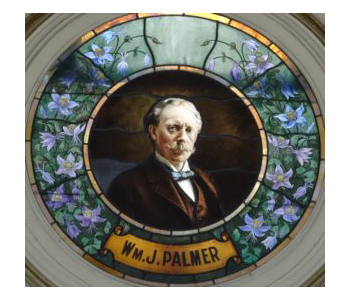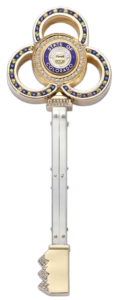Colorado State Capital
-
Men shall behold the water in the sky
And count the seasons by the living grasses
Then shall the river-namers track the sunset
Singing the long song to the shining mountains
Since they are such a rich window to the past, Lynn and I frequently visit state capitols and the third week of June found us touring our own Centennial State’s capitol building. Our capitol is indeed rich in design, artwork and history and one can get a glimpse of the past though it.
The State of Colorado is comprised of land from the Louisiana Purchase, the Republic of Texas annexation and the Mexican Cession and it was originally divided among the Kansas, Nebraska, New Mexico and Utah territories.
In 1850, gold was discovered by Lewis Ralston near the confluence of Clear Creek and what is now Ralston Creek. (Gold Strike Park, which commemorates this historic event, lays just five miles southeast of our chuch.) Ralston went on to California, but William Green Russell, a Georgian who had worked the California gold fields in the 1850s, came to Colorado and in July 1858, discovered significant gold diggings at the mouth of Little Dry Creek. When word got back east, the Colorado Gold Rush was on.
In 1861, Colorado was designated its own territory by Congress and on August 1, 1876 was admitted to the union as the 38th state. Construction of the current capitol building began in
 1886 and it was opened for use in 1894, with construction continuing through 1901.
1886 and it was opened for use in 1894, with construction continuing through 1901.Our tour guide noted that the building committee wanted to use as much material as possible from Colorado for the building, so granite from Gunnison was used for the outer walls, sandstone from Fort Collins for the foundation, yule marble from Marble for the floors and rose onyx from Beulah for the wainscoting. It was interesting to learn that the rose onyx discovered in Beulah, Colorado has never been found anywhere else in the world and that 99% of that supply is in our state capitol building.
We toured various floors and chambers as well as the dome and through it all, soaked in the beauty of the place.
The stained glass art throughout the capitol is exceptional. Many of the places in Colorado today trace their names back to the individuals depicted in these pieces – JW Denver, Chief Ouray, General William Palmer, John Evans, Benjamin Eaton, Kit Carson, etc. We took special note of the stained glass artwork depicting Edwin Johnson, Colorado US Senator from 1933 to 1957 and the 26th and 34th Colorado governor. (The eastbound bore of the Eisenhower-Johnson Memorial Tunnel is named for him.)
It turns out that our own Joan Chandler does work for Watkins studio, and that studio was commissioned to refurbish some of the stained glass of the capital. Joan repainted “Big Ed’s” face, which lacked depth and was not a good likeness.
 We also happened to run into Philip Stone, who designed the Colorado state key. (Even though I am a native to the state, I was unaware Colorado had a state key until this moment.) Mr. Stone’s granddaughter proudly introduced us and I learned that the key, which depicts our snowcapped mountains and state seal in gold, silver, diamonds and yellow and blue sapphires, was presented to Governor Lamm by Hyde Park Jewelers in 1984.
We also happened to run into Philip Stone, who designed the Colorado state key. (Even though I am a native to the state, I was unaware Colorado had a state key until this moment.) Mr. Stone’s granddaughter proudly introduced us and I learned that the key, which depicts our snowcapped mountains and state seal in gold, silver, diamonds and yellow and blue sapphires, was presented to Governor Lamm by Hyde Park Jewelers in 1984.We finished our outing with a lunch at Dozens, a delightful restaurant which features sandwiches named after familiar streets, areas of town and historical points of reference. It was the perfect place to end our tour.
As I was finishing my meal, the thoughts that kept rolling through my mind were of our duty to future generations to preserve and communicate both our personal and community heritage. This thought was punctuated by the ending lines of Mr. Ferril’s poem:
-
Beyond the sundown is tomorrow’s wisdom
Today is going to be long long ago
July 2016